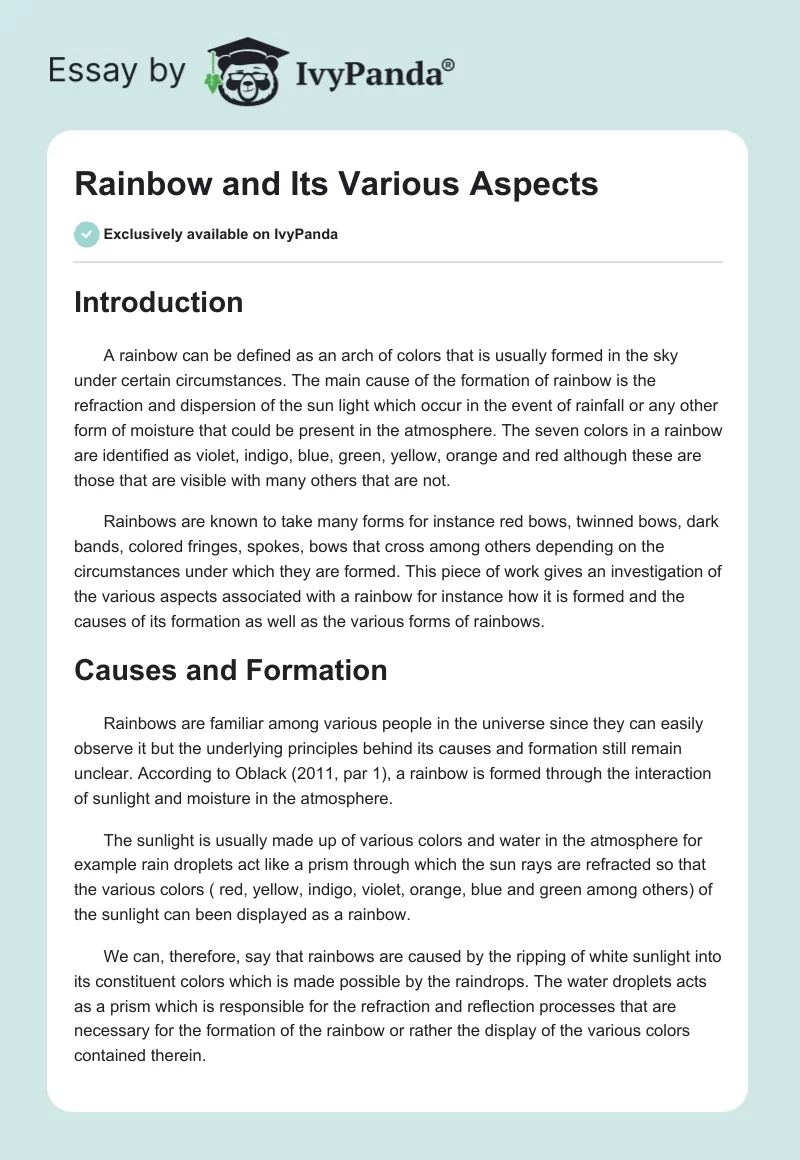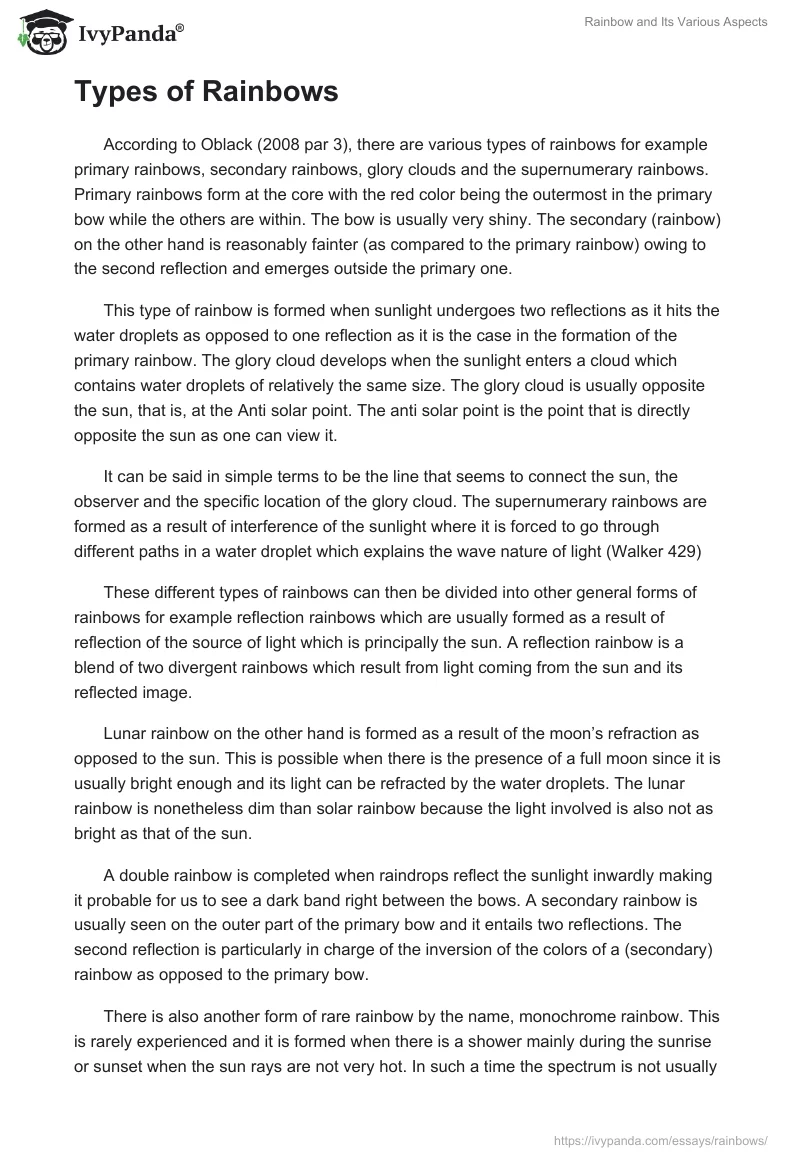Introduction
A rainbow can be defined as an arch of colors that is usually formed in the sky under certain circumstances. The main cause of the formation of rainbow is the refraction and dispersion of the sun light which occur in the event of rainfall or any other form of moisture that could be present in the atmosphere. The seven colors in a rainbow are identified as violet, indigo, blue, green, yellow, orange and red although these are those that are visible with many others that are not.
Rainbows are known to take many forms for instance red bows, twinned bows, dark bands, colored fringes, spokes, bows that cross among others depending on the circumstances under which they are formed. This piece of work gives an investigation of the various aspects associated with a rainbow for instance how it is formed and the causes of its formation as well as the various forms of rainbows.
Causes and Formation
Rainbows are familiar among various people in the universe since they can easily observe it but the underlying principles behind its causes and formation still remain unclear. According to Oblack (2011, par 1), a rainbow is formed through the interaction of sunlight and moisture in the atmosphere.
The sunlight is usually made up of various colors and water in the atmosphere for example rain droplets act like a prism through which the sun rays are refracted so that the various colors ( red, yellow, indigo, violet, orange, blue and green among others) of the sunlight can been displayed as a rainbow.
We can, therefore, say that rainbows are caused by the ripping of white sunlight into its constituent colors which is made possible by the raindrops. The water droplets acts as a prism which is responsible for the refraction and reflection processes that are necessary for the formation of the rainbow or rather the display of the various colors contained therein.
Types of Rainbows
According to Oblack (2008 par 3), there are various types of rainbows for example primary rainbows, secondary rainbows, glory clouds and the supernumerary rainbows. Primary rainbows form at the core with the red color being the outermost in the primary bow while the others are within. The bow is usually very shiny. The secondary (rainbow) on the other hand is reasonably fainter (as compared to the primary rainbow) owing to the second reflection and emerges outside the primary one.
This type of rainbow is formed when sunlight undergoes two reflections as it hits the water droplets as opposed to one reflection as it is the case in the formation of the primary rainbow. The glory cloud develops when the sunlight enters a cloud which contains water droplets of relatively the same size. The glory cloud is usually opposite the sun, that is, at the Anti solar point. The anti solar point is the point that is directly opposite the sun as one can view it.
It can be said in simple terms to be the line that seems to connect the sun, the observer and the specific location of the glory cloud. The supernumerary rainbows are formed as a result of interference of the sunlight where it is forced to go through different paths in a water droplet which explains the wave nature of light (Walker 429)
These different types of rainbows can then be divided into other general forms of rainbows for example reflection rainbows which are usually formed as a result of reflection of the source of light which is principally the sun. A reflection rainbow is a blend of two divergent rainbows which result from light coming from the sun and its reflected image.
Lunar rainbow on the other hand is formed as a result of the moon’s refraction as opposed to the sun. This is possible when there is the presence of a full moon since it is usually bright enough and its light can be refracted by the water droplets. The lunar rainbow is nonetheless dim than solar rainbow because the light involved is also not as bright as that of the sun.
A double rainbow is completed when raindrops reflect the sunlight inwardly making it probable for us to see a dark band right between the bows. A secondary rainbow is usually seen on the outer part of the primary bow and it entails two reflections. The second reflection is particularly in charge of the inversion of the colors of a (secondary) rainbow as opposed to the primary bow.
There is also another form of rare rainbow by the name, monochrome rainbow. This is rarely experienced and it is formed when there is a shower mainly during the sunrise or sunset when the sun rays are not very hot. In such a time the spectrum is not usually full and the shorter wavelengths are usually absent or scattered making the rainbow appear quite different as compared to when the sun is still very hot.
The fact that the spectrum is not usually full when the monochrome rainbow appears is not a justification that these types of rainbows appear under the moonlight. This is because rainbows under moonlight appear in the presence of a full spectrum but they seem to be white in color due to our inability to see the colors clearly (The National Center for Atmospheric Research par 12).
General Facts In Regard To a Rainbow
It is argued that for an individual to view a rainbow there must be the presence of both the sun and moisture in the atmosphere. One also has to be at an angle of approximately 42 degrees to view it clearly. A rainbow is not located at a particular position in the sky as many people may think but rather its position is dependent upon some factors for instance the sun’s position at a particular time and the viewer’s location. It is made of more than the seven colors we see and the colors are also seen differently by different people.
The rainbow appears in the opposite direction in respect to the sun in regard to the viewer’s perspective with the core part of the rainbow appearing to be brighter as compared to the external areas of the rainbow.
Rainbows formation is made possible due to the geometry of raindrops and it follows that the sun usually shine from behind us and its rays enter the raindrops where they are refracted inwards then reflected from the raindrop and finally refracted from it coming back to the viewer’s eyes. For there to be a rainbow formation, the sunbeams are refracted as it goes into the surface of a water droplet then reflected to the back of the droplet and finally refracted in the event of leaving the droplet.
This causes reflection of the incoming sunlight over various angles to a maximum of around 42 degrees depending on aspects like the size of the droplet and the refractive index which is different in different waters. The rainbow colors are in the shape of a circle but as we observe it we just see part of the circle due to the long distance hence the arch shape (Anonymous 1).
Rainbows are perceived differently with many myths being formulated in regard to their presence. It is associated with various cultural and religious aspects depending on various societies and their beliefs. It has for example been considered in Greek to be the trail that was made between the earth and heaven by Iris, a messenger.
The people of China on the other hand had for a long time believed that a rainbow stood for an incision in the sky which had been closed up by a goddess employing stones that were of diverse colors. Some of these myths have been proven wrong as research has advanced and people have been able to gain a clear understanding of various aspects of rainbows (Supriya 2).
The aspect of rainbows have been studied for a very long time especially while studying other aspects of reflection and refraction but it is evident that people still know little about the underlying concepts of the rainbows for instance causes and even the circumstances through which they are formed.
Works Cited
Anonymous. “What causes a rainbow?” Howstuffworks, 2011. Web.
Oblack, Rachelle. “Glory Clouds’. About. 2008. Web.
Oblack, Rachelle. “Rainbows”. About. 2011. Web.
The National Center for Atmospheric Research. “About Rainbows.” Ucar, 2011. Web.
Supriya, Sharon. “Interesting Myths and Facts about the Rainbow”. Oneindia, 2008. Web.
Walker, Jearl. Multiple Rainbows from a Single Drop of Water and Other Liquids. American Journal of Physics Vol. 44, No. 5, pages 421-433 1976.




